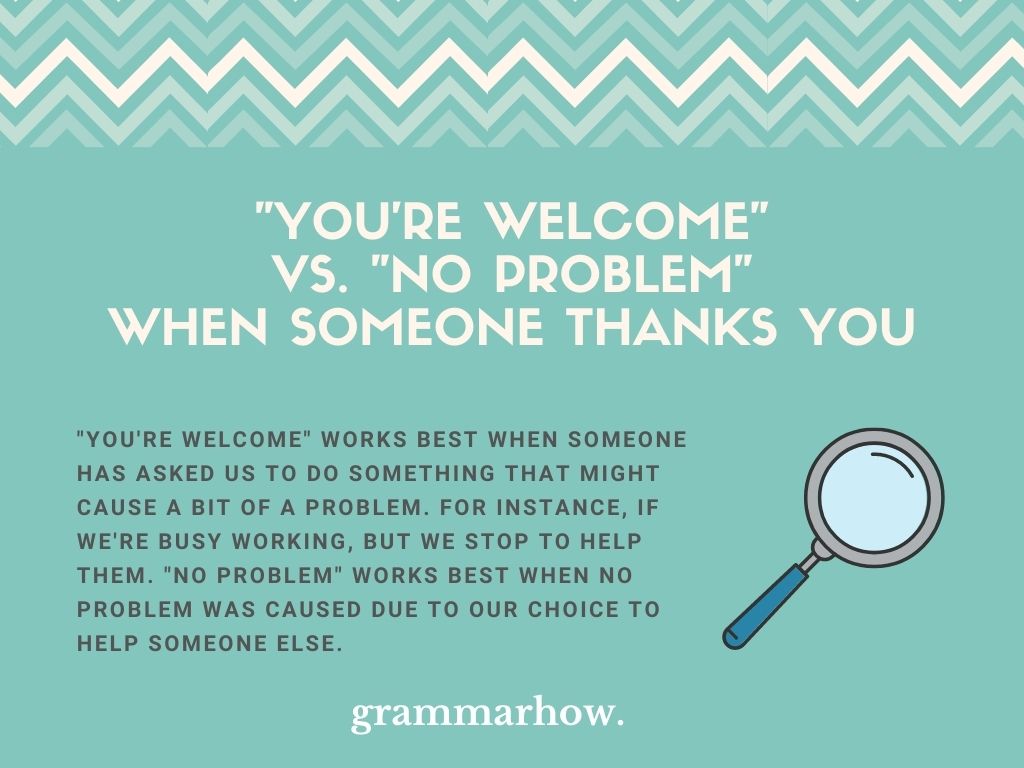If you’ve ever replied to “thank you,” you’ve probably found yourself using both “you’re welcome” and “no problem.” You might think they’re both the same phrase with the same meaning, but this is not the case. This article will explore the two meanings for you.
What Is The Difference Between Saying “You’re Welcome” And “No Problem” When Someone Thanks You?
“You’re welcome” works best when someone has asked us to do something that might cause a bit of a problem. For instance, if we’re busy working, but we stop to help them. “No problem” works best when no problem was caused due to our choice to help someone else.

Now that we’ve worded it that way, it probably makes a lot more sense to you, right? It seems reasonable to expect “no problem” to be related to accepting “thanks” when no actual problem was caused to us.
Let’s break it down more with two different examples:
- “Excuse me, Dave. Could you help me with this problem?”
Let’s pretend that we are Dave. We’re currently not busy. In fact, we’re sitting at our desk waiting for something interesting to do. So, we accept to help this person with their “problem.”
Once we start working on the problem, we realize that it won’t take more than two minutes to fix, and we do just that. Suddenly, we hear this:
- Thank you, Dave.
- No problem.
We say “no problem” because there wasn’t much of a problem for us to do the task. We weren’t busy, we didn’t find it hard, and we got it done quickly. It didn’t cause us any unnecessary stress, so “no problem” works well.
Now, let’s repeat the experiment, but with a different situation:
- “Excuse me, Chris. Could you help me with this problem?”
Now, we are Chris. However, Chris is currently swamped with paperwork. We’ve got to get through all of it before the end of our shift (which is only in thirty minutes). Nevertheless, we are the employee, and we owe it to the person that needs help to give them a hand.
So, while we might not be the most useful person for them, we still agree to help. Let’s also assume the task took about fifteen minutes, and we had to go through multiple different ideas before figuring out the correct solution. Now, we hear this:
- Thank you, Chris.
- You’re welcome.
This time, “you’re welcome” is more suitable. We say “you’re welcome” because it was actually quite difficult for us to help the person out.
We had to stop doing our own work and had to spend more time trying to fix their problem. We did them a favor, so “you’re welcome” is best.
When Should I Reply “You’re Welcome” To “Thank You”?
Let’s go over the two phrases a little closer. This time, we’ll mainly focus on examples, as we think this will help you understand it better.
“You’re welcome” works as a reply to “thank you” when you want to help somebody, even if it causes trouble for you. You might have found it difficult to help them or have to give up your own work to do so.
If you took some time out of your day to help someone else, then “you’re welcome” is usually the best choice for you.
Here are some examples to show you how it might work:
- Thank you for spending all of that time working with me yesterday. I know it couldn’t have been easy.
- You’re welcome.
- Thank you for taking time off to help me renovate my house.
- You’re welcome.
- Thank you for giving me a hand with this. I knew you were busy, but I didn’t have anyone else to go to.
- You’re welcome.
- Thank you for spending some time with me today. I know I can be difficult.
- You’re welcome.
- Thank you for agreeing to work overtime this week, Michael.
- You’re welcome.
- Thank you for agreeing to work over this weekend. No one else would agree.
- You’re welcome.
These examples all show someone “thanking” us for something we probably didn’t want to do. We might have been made to agree to it, which isn’t ideal, but sometimes that’s just how the world works.
“You’re welcome” shows that you would rather have done other things, but you’re happy to help nonetheless.
When Should I Reply “No Problem” To “Thank You”?
“No problem” is the better reply when you are happy to have helped someone and didn’t put yourself out to do it. This can apply when you don’t have much work to do yourself or when you really like the person that’s asked you to help out.
The “problem” portion of this reply is what is most important. When we say “no problem,” it means exactly that. We did not have a “problem” helping somebody out.
Here are some examples to show you the different situations where this might apply:
- Thank you for helping me with these messages.
- No problem! I had nothing else to do anyway.
- Thank you for your help.
- No problem. I’ll happily do it again.
- Thank you for your kind words.
- No problem. I meant every one of them.
- Thank you for being there for me.
- No problem. You’ve always been there for me too.
- Thank you for giving me a hand with this.
- No problem. I know you would have done the same for me.
- Thank you for helping out today.
- No problem. I didn’t even have to think about my answer!
“No problem” works best when someone is thanking us for something that we didn’t think we needed to be thanked for.
When Should I Reply “No Worries” To “Thank You”?
“No worries” is another common way to accept a “thank you.” However, it’s not as tied into one case as the other two forms.
“No worries” is the most informal form of the three. We use it to accept any thank you message, and it can apply whether we are busy or not. It can be synonymous with “you’re welcome” and “no problem,” depending on the context it’s used.
These examples will demonstrate how it works to replace “you’re welcome:”
- Thank you for looking after the store for me today. I know you like having today off.
- No worries, mate.
- Thank you for coming in again to help out with this event.
- No worries.
- Thank you for listening. I know I probably took you away from something you enjoy doing.
- No worries.
And here are some examples to show you how it replaces “no problem:”
- Thank you for being so nice to me!
- No worries! You deserve it.
- Thank you for giving me a hand.
- No worries. I’ve got your back.
- Thank you for getting those invites out.
- No worries. It was easy.
Are “You’re Welcome,” “No Problem,” And “No Worries” Interchangeable?
To most native speakers, the three forms are interchangeable. It depends mostly on where you’re using them.
In written English, it’s best to stick with “you’re welcome” when you have committed time to help someone and “no problem” when you have found it easy. In spoken English, the two phrases (as well as “no worries”) as synonymous because the rules are relaxed.
Spoken English rarely follows the same rules as written English.
It’s common for native speakers to answer any “thank you” with any of the three choices. We can prove that with the following:
- Thank you for helping.
- You’re welcome.
- Thank you for helping.
- No problem.
- Thank you for helping.
- No worries.
Most native speakers won’t worry too much about the differences when only using them in the spoken form.
Is It Nicer To Say “You’re Welcome” Or “No Problem”?
“No problem” is the nicer phrase of the two. It works well because it shows that you were happy to help, and you don’t want to take away from the attention of the thanking party. “You’re welcome” can come across as arrogant in some cases.
We can demonstrate this by referring to the phrases in their longer forms:
- Thank you for helping me.
- It was not a problem for me at all.
“No problem” means “not a problem for me,” meaning we were happy to help.
- Thank you for helping me.
- You are welcome because I gave you my time and effort.
“You’re welcome” can sound much more arrogant when we turn it into this form (which is the expected way that most people use it).
Is Saying “No Problem” Rude?
“No problem” is not rude. You can use it when you want to show that you’re happy to assist somebody. Some people think it’s more informal than “you’re welcome,” but there are no grammatical rules that share this view.
Is “No Problem,” “You’re Welcome,” Or “No Worries” Used The Most?
According to Google Ngram Viewer, “no problem” is by far the most popular choice of the three forms. We can use it whenever we want to accept someone’s “thank you.”

“You’re welcome” and “no worries” are almost identical in usage. This shows that they’re also acceptable, but they’re much less common than “no problem.”
You may also like:
Should I Reply “You’re Welcome” To A Thank You Email?
12 Best Replies To A Thank You Email From Your Boss
26 Best Replies To “Thank You” (Formal & Informal)

Martin holds a Master’s degree in Finance and International Business. He has six years of experience in professional communication with clients, executives, and colleagues. Furthermore, he has teaching experience from Aarhus University. Martin has been featured as an expert in communication and teaching on Forbes and Shopify. Read more about Martin here.
